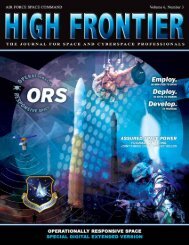Space Acquisition - Air Force Space Command
Space Acquisition - Air Force Space Command
Space Acquisition - Air Force Space Command
You also want an ePaper? Increase the reach of your titles
YUMPU automatically turns print PDFs into web optimized ePapers that Google loves.
Figure 2. Template knowledge points.<br />
proach for the formation of new programs and acquisitions. A<br />
detailed set of appendices provides a “desk reference.” Aerospace<br />
is working to integrate course materials into acquisition<br />
guidance, systems engineering plans, mission assurance products,<br />
and IPA guidance materials.<br />
Developing a Consistent, Credible <strong>Acquisition</strong> Risk<br />
Strategy<br />
Aerospace has codified a set of core processes and supporting<br />
disciplines to ensure successful development, deployment,<br />
and operation of space systems ranging in type and complexity.<br />
In the context of a major engineering endeavor such as the<br />
acquisition of a space system, mission assurance is that part<br />
of the systems engineering and integration activities that, by<br />
means of a combination of design validation and product verification,<br />
provide both the designer and the user with a high degree<br />
of confidence in the successful execution of the required<br />
system functions.<br />
Consistent with this perspective, mission assurance is at the<br />
core of the Aerospace charter and represents one of the primary<br />
technical functions that Aerospace performs for its NSS<br />
customers. Accordingly, Aerospace has prioritized a series of<br />
development initiatives that better document and facilitate the<br />
application of mission assurance processes. One of these initiatives<br />
led to the publication of the Mission Assurance Guide.<br />
The Mission Assurance Guide addresses mission assurance<br />
from a systems engineering perspective. It introduces the fundamental<br />
principles and objectives, and then further defines<br />
them in practical terms as a hierarchically organized set of<br />
standard processes and methodologies. These processes cover<br />
the complete life cycle of space, launch, and ground system<br />
programs, from concept to disposal, and are systematically interwoven<br />
in their application to achieve a successful and repeatable<br />
mission outcome.<br />
Mission assurance objectives complement key acquisition<br />
tasks. For example, in the early conceptual phases of a program,<br />
the primary objective is to ensure that the architecture<br />
and system requirements are aligned with user needs<br />
and expectations. A parallel and equally important<br />
goal is to lay the contractual groundwork for staffing,<br />
generation of design-relevant data, and open communications<br />
necessary for successful program execution.<br />
As the program moves from design through fabrication<br />
to checkout and operation, the mission assurance focus<br />
moves accordingly to ensure that the integrity of the<br />
system design is maintained throughout.<br />
The guide defines mission assurance in terms of<br />
a reference set of core mission assurance processes,<br />
supporting mission assurance disciplines and associated<br />
tasks. This definition draws from a foundation<br />
of systems engineering principles and from Aerospace<br />
experience in applying engineering best practices to<br />
the procurement and launch-readiness certification of<br />
space systems. This experience has established that a<br />
judiciously combined application of the mission assurance<br />
processes and disciplines maximizes the likelihood<br />
that a system will not only meet its basic, specified performance<br />
requirements, but also user expectations regarding<br />
safety, operability, suitability, and supportability.<br />
Core mission assurance processes identify and organize—in<br />
a standard systems engineering execution flow that naturally<br />
lends itself to actual programmatic implementation—tasks that<br />
focus on the validation and verification of system acquisition<br />
activities.<br />
The core processes can actually be executed through a combination<br />
of tasks and technical approaches that can vary in nature<br />
and depth. A degree of flexibility is in fact necessary to<br />
accommodate the scope and constraints of each specific space<br />
program implementation. Such flexibility is achieved through<br />
a tailoring process, which is an essential element in defining the<br />
program mission assurance plan (see figure 3).<br />
The implementation of mission assurance cannot succeed<br />
without a solid foundation of baseline activities executed by<br />
space program contractors and suppliers. Beyond that, however,<br />
mission assurance requires detailed technical insight into<br />
each program by a truly independent organization to measure<br />
the effectiveness and outcome of core processes and tasks.<br />
Through the disciplined application of mission assurance practices,<br />
Aerospace has contributed to the current string of successful<br />
launches and their associated missions on orbit.<br />
Besides the definition of reference processes and disciplines,<br />
successful programmatic implementation of mission assurance<br />
methodologies relies on the application of risk criteria to tailor<br />
processes and tasks onto a specific program based on resource<br />
and schedule constraints and system priorities. Thus,<br />
the breadth and depth of mission assurance processes for a given<br />
program will depend on several factors, including budget,<br />
schedule, technology maturity, purpose, and mission criticality.<br />
An essential extension of the guide is a database of the mission<br />
assurance tasks that it references. These tasks—grouped<br />
according to execution timelines, hierarchy, and functional organization—are<br />
selected and tracked using a software tool associated<br />
with an extensive database. This combination of data-<br />
High Frontier 24











